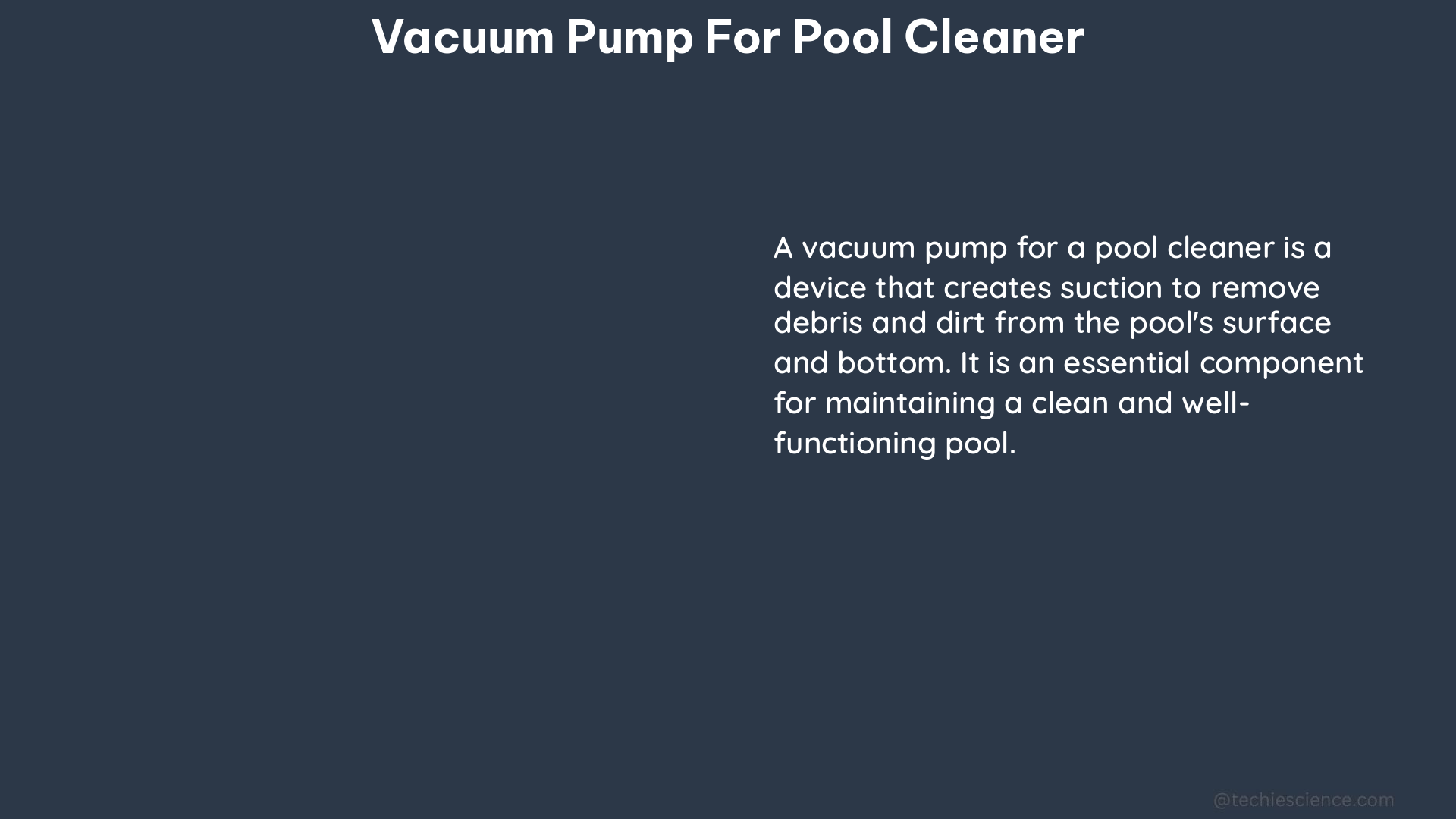A vacuum pump is a crucial component in maintaining a clean and efficient pool. It plays a vital role in powering pool cleaners, providing the necessary suction to lift debris from the pool floor. Understanding the technical specifications and proper maintenance of a vacuum pump can help pool owners optimize their cleaning system and extend the life of their equipment.
Horsepower (HP) Rating: The Heart of Suction Power
The horsepower (HP) rating of a vacuum pump is a key factor in determining its ability to drive a pool cleaner effectively. A higher HP rating generally translates to greater suction power, which is essential for efficient debris removal. For instance, the Krystal Clear Model 635T Filter Pump, with a flow rate of 1500 gallons per hour (gph), does not provide information about its HP rating. However, a pump with a higher HP rating, such as the Hayward SP2610X15 Super Pump, which has a 1.5 HP motor, can generate more suction power and effectively clean a larger pool.
Technical Specifications: Unlocking the Potential of Vacuum Pumps

Vacuum pumps for pool cleaners typically have the following technical specifications:
-
Flow Rate: This is the volume of water that the pump can process in a given time, usually measured in gallons per hour (gph). Higher flow rates, such as the 3,000 gph of the Pentair IntelliFlo Variable Speed Pool Pump, indicate a more powerful pump capable of handling larger pools.
-
Suction Power: Measured in inches of mercury (inHg), suction power determines the pump’s ability to lift debris from the pool floor. A higher suction power, like the 18 inHg of the Hayward SP2610X15 Super Pump, ensures more effective cleaning.
-
Power Consumption: This is the amount of electrical power the pump consumes, measured in watts or amps. Lower power consumption, such as the 230-460 watts of the Pentair IntelliFlo Variable Speed Pool Pump, indicates a more energy-efficient pump, reducing operating costs.
-
Motor Type: Pumps can have single-speed, two-speed, or variable-speed motors. Variable-speed motors, like the Pentair IntelliFlo, offer greater energy efficiency and customization options, allowing users to adjust the pump’s speed to match the specific cleaning needs.
-
Noise Level: Measured in decibels (dB), lower noise levels, such as the 45-56 dB range of the Pentair IntelliFlo, indicate a quieter operation, which can be important for residential pool owners.
Maintaining the Longevity of Your Vacuum Pump
To maximize the life of your vacuum pump, regular maintenance is essential. This includes:
-
Oil Changes: Oil-sealed rotary pumps, such as the Gast R4110A-8CM-G588DX Rotary Vane Vacuum Pump, should have their oil changed after every 3,000 hours of operation to ensure proper lubrication and prevent wear.
-
Inspections: Pumps should be regularly inspected for any signs of wear or damage. Diffusion pumps, like the Edwards RV8 Rotary Vane Vacuum Pump, should be checked for contamination and buildup that can affect their performance.
-
Cleaning: Keeping the pump’s air intake and other components clean is crucial for maintaining optimal efficiency. Regularly cleaning the pump, as recommended by the manufacturer, can help prevent issues and extend its lifespan.
-
Proper Installation: Ensuring the vacuum pump is installed correctly, with proper ventilation and alignment, can contribute to its longevity and performance.
-
Monitoring Performance: Regularly monitoring the pump’s performance, such as checking for any changes in flow rate, suction power, or power consumption, can help identify potential issues before they become major problems.
By following these maintenance best practices, pool owners can maximize the life of their vacuum pumps and maintain a clean, efficient pool cleaning system.
Conclusion
Vacuum pumps for pool cleaners are essential components that require careful consideration of their technical specifications and proper maintenance. Understanding factors like horsepower rating, flow rate, suction power, power consumption, motor type, and noise level can help pool owners select the right pump for their needs and optimize its performance. Regular maintenance, including oil changes, inspections, and cleaning, is crucial for extending the life of the vacuum pump and ensuring a clean, well-maintained pool.
References:
– Case Study: Improving Pool Pump Efficiency
– Vacuum Pump Maintenance: Tips and Tricks
– ENERGY STAR Pool Pumps Specification
– Pump Horsepower Needed for Suction Cleaner
– How to Make a Pool Porta Vac Pump

The lambdageeks.com Core SME Team is a group of experienced subject matter experts from diverse scientific and technical fields including Physics, Chemistry, Technology,Electronics & Electrical Engineering, Automotive, Mechanical Engineering. Our team collaborates to create high-quality, well-researched articles on a wide range of science and technology topics for the lambdageeks.com website.
All Our Senior SME are having more than 7 Years of experience in the respective fields . They are either Working Industry Professionals or assocaited With different Universities. Refer Our Authors Page to get to know About our Core SMEs.